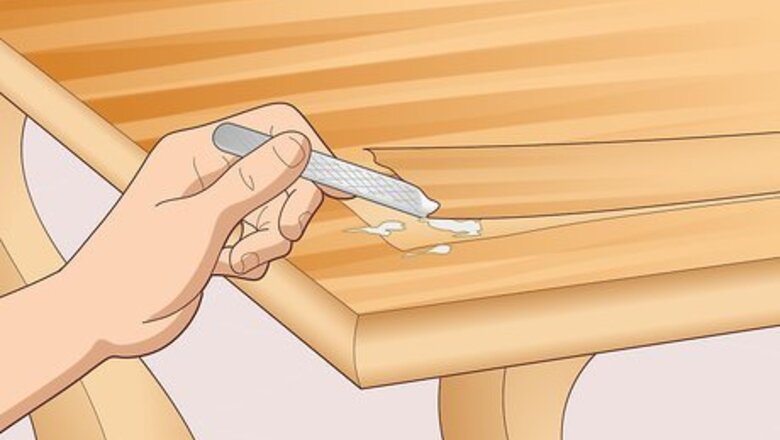
views
Gluing Lifted Edges
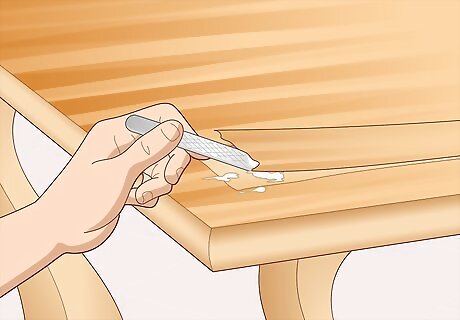
Scrape off the dry glue underneath the veneer with a file or paperclip. Carefully lift the edge of the veneer so you can fit the file or paperclip underneath it. Rub the surface under the veneer with the file to break down any leftover glue that’s still stuck on the furniture. Blow away the dust so you can see your work area clearly. Continue removing as much of the glue as possible. Be careful not to pry the veneer too far up since you could cause it to break or snap.Variation: If you have trouble blowing away the dust, flatten the end of a plastic straw and position it under the veneer. Blow into the open end of the straw to get rid of the dust.
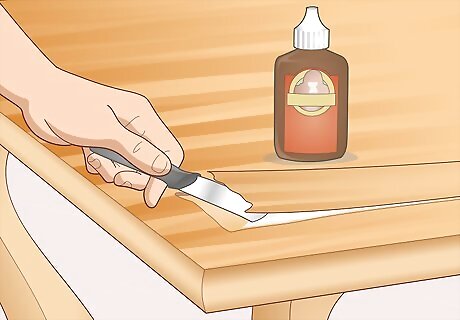
Spread wood glue onto the surface under the veneer using a palette knife. Apply a bead of wood glue along the edge of a palette knife and lift the veneer with your nondominant hand. Position the blade of the knife between the veneer and piece of furniture and scrape it over the wood. Try to make the layer as thin and even as possible to ensure proper adhesion. Palette knives have flat, flexible heads so you can easily spread glue in tight areas. You can buy them from an art supply or hardware store. If you don’t have a palette knife, you can also spread the glue with a toothpick.
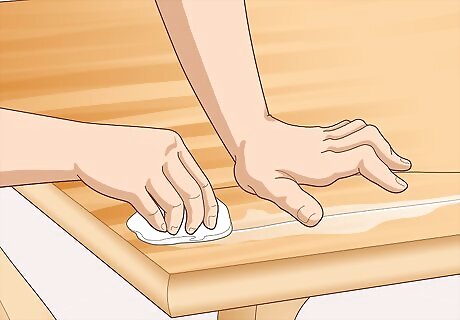
Press the veneer down and wipe away excess glue with a damp shop cloth. Wet a shop cloth with warm water and wring it out completely. Push down firmly on the top of the veneer to help spread the glue out more. Work from the center of the raised area toward the edges to force any excess glue out from the sides. Wipe any glue that comes out with the cloth so it doesn’t dry. Push lightly for the first few times to help flatten large bubbles of glue underneath the veneer. Avoid leaving the wood glue on furniture since it will be more difficult to remove later on.
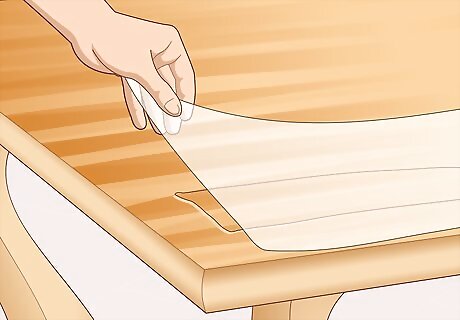
Lay a piece of wax paper on the veneer. Set a sheet of wax paper over the edge with the shiny side face-down so it covers the entire glued area. Make sure you have about 1 inch (2.5 cm) of wax paper extending past the glued section so glue is less likely to leak out the sides. If you don’t use wax paper, the glue may ooze out and stick to clamps later on.
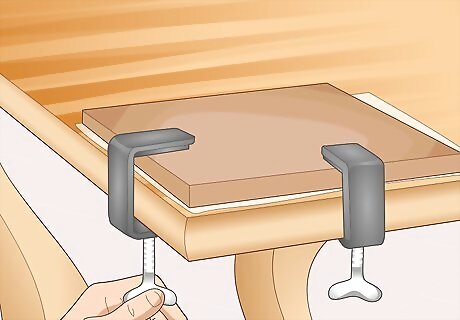
Clamp a flat piece of wood on top of the wax paper and leave it overnight. Choose a piece of wood that has a flat side large enough to cover the glued section. Lay the wood over the wax paper and secure it to your work surface with a C-clamp. Add additional C-clamps every 6 inches (15 cm) down the length of the wood so it doesn’t rise up away from the veneer. Leave the clamps on the wood overnight so the wood has time to dry. Clamping the veneer down ensures it’s flat against the furniture so it’s less likely to develop blisters or damage in the future. You can buy C-clamps from your local hardware store. You can use any scrap piece of wood as long as it has a flat surface and covers any section you glued.
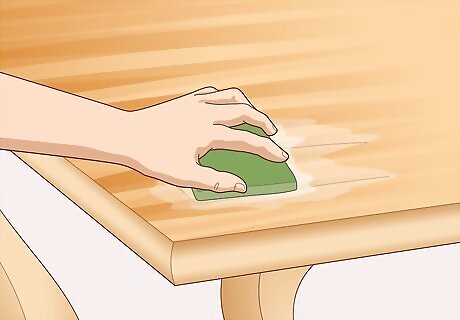
Clean off any dried glue with a damp shop cloth or abrasive pad. Wet a shop cloth with warm water and wring out so it doesn’t drip. Lightly rub over the edges to see if any excess dried glue comes off. If the glue still sticks on the exterior of the vinyl, use an abrasive sponge and apply light pressure to break it down. Avoid applying firm pressure while you’re removing glue since you could scrape through the veneer’s surface and make it discolored.
Flattening Blisters in Veneer
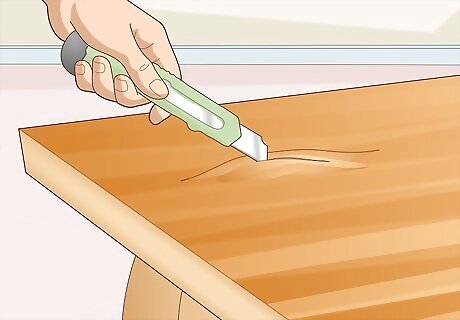
Cut a slit in the middle of the blister with a utility knife to drain out the air. Position your cut so it runs with the wood grain to make it less noticeable. Push a utility knife lightly into the veneer until you pierce through the other side. Make the slit about half the length of the blister so you can easily poke a syringe inside of it later on. Blisters occur when you set something hot on the veneer, which separates the adhesive from the wood to create a bubbled area on the surface. Always cut away from your body so you don’t injure yourself if the knife slips.
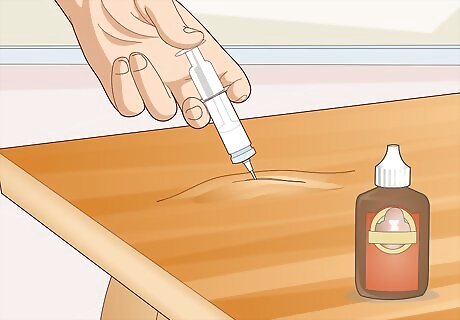
Apply wood glue on the surface inside the blister with a syringe. Get a wood glue syringe from your local hardware store and remove the cap on the needle. Put the needle in one side of the slit on the veneer and press down on the plunger. Move the needle tip around the inside of the blister to spread the glue evenly. Then apply glue to the other side of the slit in the same way. If you don’t have a wood glue syringe, you can spread wood glue with a toothpick or palette knife.
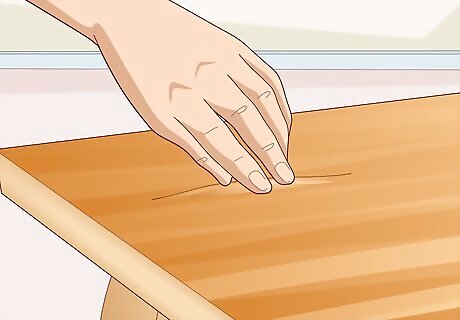
Press down on the blistered veneer to spread the glue. Push from the edges of the blister toward the slit in the center. Apply firm pressure as you work to help create a thin, even layer of glue underneath the blister. Try to make the blister as flat as possible so it adheres to the surface easier. If any excess glue comes out from the slit, wipe it away with a damp shop cloth.
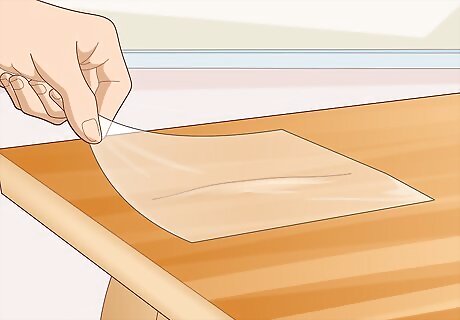
Set wax paper over the blistered veneer. Tear off a sheet of wax paper that extends about 1–2 inches (2.5–5.1 cm) around the blister on each side. Put the wax paper with the shiny side face-down so it presses against the veneer. Wax paper helps prevent the clamps from sticking to the veneer if glue oozes out from the blister.
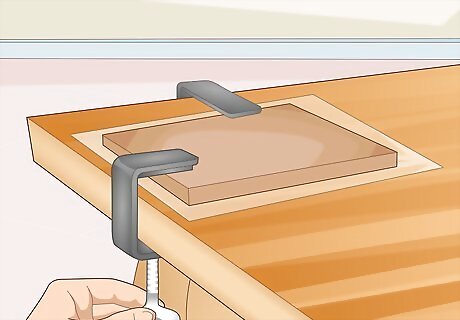
Clamp a flat piece of wood over the veneer and leave it overnight. Set a flat piece of wood on top of the wax paper that’s large enough to cover the entire blister. Secure a C-clamp to your piece of furniture or work surface so it holds the wood block tightly against the veneer. Put additional clamps every 1 foot (30 cm) if the block doesn’t stay flat against the veneer. Leave the veneer clamped overnight so the wood glue has time to set. Avoid removing the clamp or wood block any earlier since the veneer could still raise off the furniture and form another blister.Variation: If you don’t have any C-clamps, you can also set heavy objects, such as books or a paint can, on top of the wood block to hold it firmly.
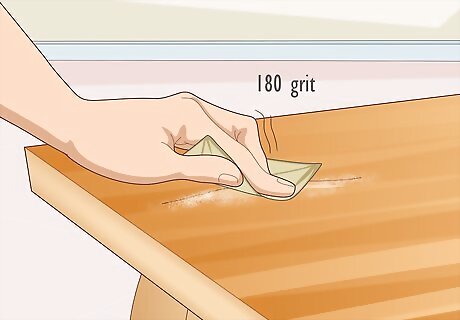
Sand the dried glue on top of the veneer with 180-grit sandpaper. Take off the clamps, wood block, and wax paper so you can see your repair. Apply light pressure as you work 180-grit sandpaper over the slit. Remove the dried glue around the hole and continue smoothing out the edges until they’re flush with the rest of the veneer. Don’t press too hard with the sandpaper, or you may sand through the veneer and cause discoloration. Blow the dust away or wipe it off with a damp cloth periodically so you can see what you’re doing.
Using Wood Filler for Chips
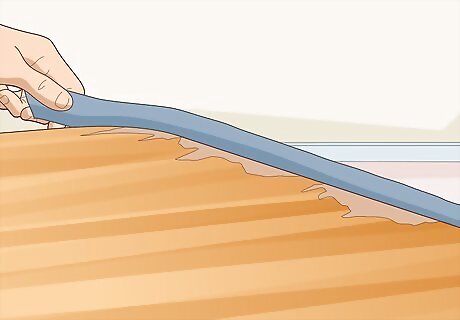
Tape around the chipped area if it’s along the edge of the veneer. Attach a strip of painter’s tape along the outer edge of the furniture so it extends about 1 inch (2.5 cm) over the surface. Make sure the tape forms clean, straight walls around the outer edges of the veneer. Continue applying tape around any corners or sides that have chips. Painter’s tape helps form straight, clean edges with the wood filler. This works well if you’re fixing chips in the corners of drawers or along a table’s edge. You don’t need to apply tape if you’re filling chips that aren’t along the edge.
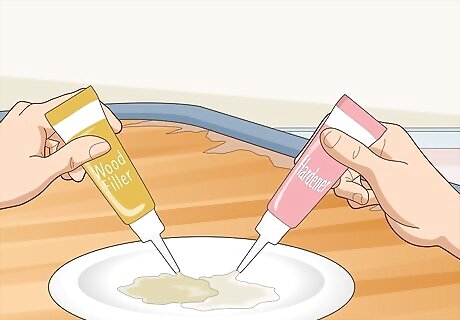
Combine wood filler and hardener on a paper plate. Read the mixing directions on the wood filler packaging and add enough to a paper plate to fill in the chips on your furniture. Add the listed amount of the hardening solution and mix it into the filler with a stir stick. Continue stirring the wood filler until it gets tacky. You can buy wood filler from your local hardware store. You can also use a matching-colored wood putty for this. Make sure to use a stainable wood filler if you want to match the color of the original veneer. If you plan on painting over the veneer later on, then you can use any wood filler. Work quickly after combining the wood filler and hardener since it will start setting with 15 minutes and be difficult to work with.Warning: Avoid using any plates or bowls you normally use to eat since the wood filler will be difficult to clean and remove without damaging them.
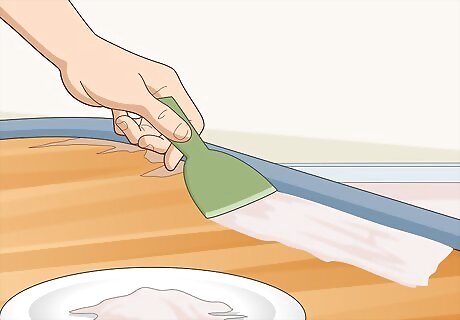
Press the wood filler into the damaged sections with a plastic scraper. Scoop the wood filler off of the paper plate with a plastic scraper and push it into the area that’s damaged. Move the scraper in multiple directions while applying firm pressure so the filler works deeper into the wood and veneers. Make sure corners and edges are as straight as possible. Scrape the surface flat and remove any excess wood filler. If you have trouble scooping or pressing the wood filler into the chipped sections, it may have dried out before you were able to use it. Scoop out as much as you can before combining more wood filler with hardener.
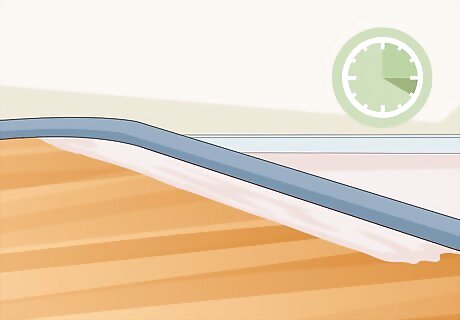
Allow the filler to dry for about 15–20 minutes. Leave the wood filler alone in a dry place so it has time to harden. Lightly tap on the wood filler after 15 minutes to see if it’s solid. If it still feels wet, allow it to dry for another 10–15 minutes before checking again. Wood filler may take up to 2 hours to completely set if you filled in large areas.
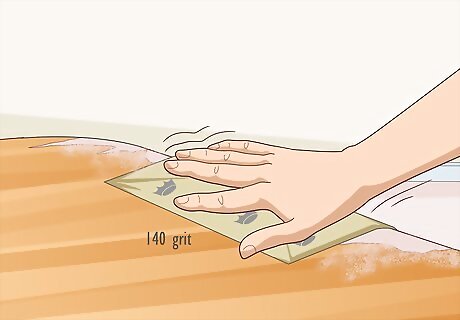
Sand the wood filler with 140-grit sandpaper so it’s flush with the veneer. Remove any tape around the wood filler before rubbing any rough edges with 140-grit sandpaper. Work in the same direction as the wood grain on the veneer to help the wood filler blend in easier. Apply light pressure to get rid of raised seams or uneven applications until they feel smooth. Be careful not to oversand since it will make the surface look uneven.
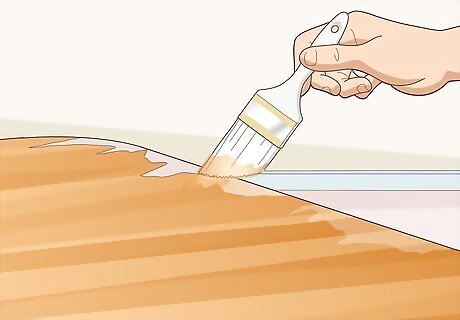
Apply stain to the wood filler so it matches the veneer. Test the stain on an inconspicuous area of the wood filler first to ensure the color matches the rest of the veneer. Brush the stain on with a paintbrush and follow the direction of the wood grain so it blends in easier. Allow the stain to dry completely, which usually takes 6–8 hours. Try using a wood stain marker if you’re filling in sections smaller than 1 square inch (6.5 cm). You don’t need to apply stain if you plan on painting over the veneer and wood filler.
Patching Heavily Damaged Veneer
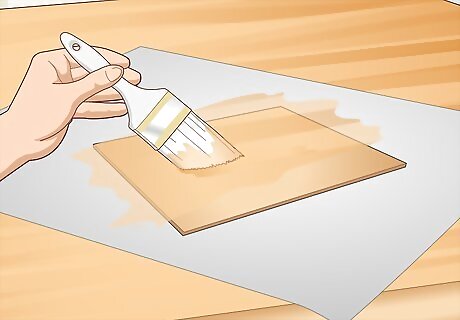
Stain a piece of replacement veneer to the same color as the original. Use a stain color that matches the color of the existing veneer and test it on a scrap piece to ensure it’s the same color. Paint a layer of the stain onto the replacement veneer with a paintbrush and wipe off any excess with a shop cloth along the wood grain. Let the stain dry for 6–8 hours before using the replacement veneer. Be sure to use veneer that's the same thickness as the original, or else it won't look cohesive. You can buy new pieces of veneer from most furniture supply stores.
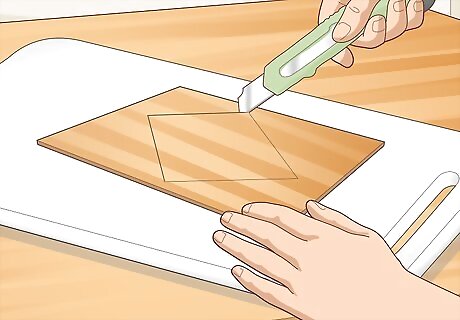
Cut a diamond-shaped patch from the replacement veneer. Make the patch large enough so it completely covers the damaged area you’re replacing. Align the wood grain so it’s at a 45-degree angle to the sides. Use a utility knife and a straightedge to cut out your patch. Diamond-shaped patches help you hide the seams between the replacement and original veneers since they’ll be at an angle.
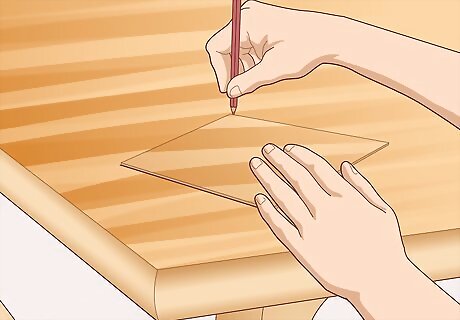
Trace the outline of the patch around the damaged veneer. Set your patch over the damaged area so the edges are at an angle to the wood grain and the grain matches between the replacement and original veneers. Hold the patch firmly in place with your nondominant hand and trace around it with a pencil. Make your lines dark enough so you’re able to see them while you’re working. Set the patch aside while you’re working for now. Always work directly from the patch rather than taking measurements since you may cut the shape or position it incorrectly.
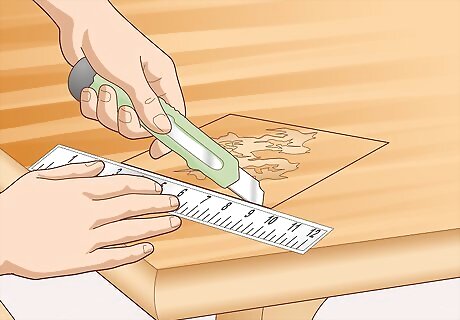
Slice through the veneer along the outline using a utility knife. Place a straightedge against your outline and press a blade into the veneer at the start of your cut. Only push the blade deep enough to cut through the veneer, which is usually about ⁄8 in (0.32 cm) thick. Pull the blade along the outline to loosen the veneer around the area you’re patching. If you press too far down with the blade, you could damage the wood underneath. Always move the blade away from your body you don’t get hurt if the knife slips.
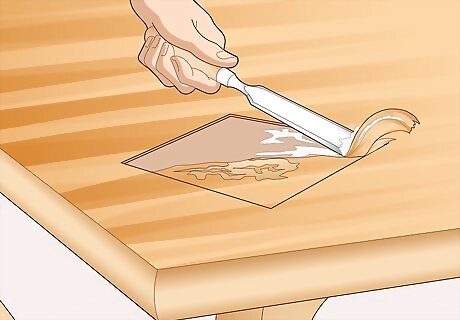
Chisel off the old veneer and glue from the damaged area. Place the sharp, flat end of the chisel against the bottom edge of the veneer. Hold the chisel near horizontal and push it forward lift up the old veneer. Work in small, short strokes so you don’t damage or gouge the wood underneath. Work toward the outline you cut with your knife and throw away the old veneer pieces as they chip off. If you have trouble guiding the chisel through the veneer, lightly tap on the end of the handle with a hammer or mallet to help force it through. If you accidentally gouge into the wood underneath the veneer, fill it in with wood filler and allow it to cure before attaching the patch.
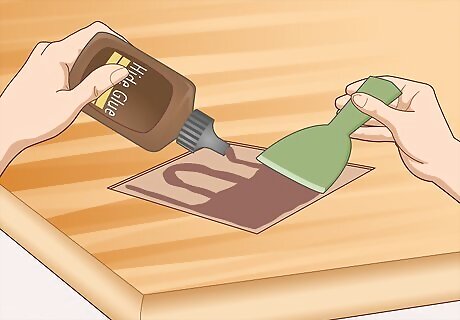
Apply hide glue to the chiseled furniture surface. Apply the hide glue directly onto the clean surface where you want to place your patch. Use a palette knife or a plastic scraper to spread the glue over the entire surface to create a thin, even layer. Work quickly after applying the glue since it begins setting within 15–20 minutes. You can buy hide glue from your local hardware store. Avoid using wood glue since it may not adhere as well.Tip: If you’re worried glue oozing onto the original veneer, apply strips of painter’s tape around the edge of the patch. You will still be able to clean the glue off if you don’t tape it.
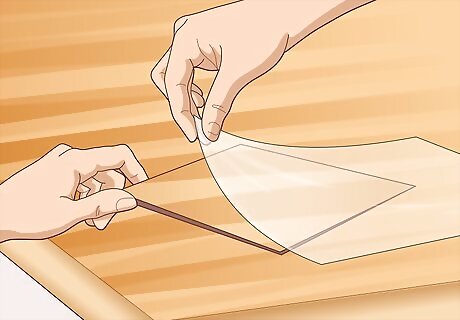
Set the veneer patch and a sheet of wax paper onto the glued surface. Position the veneer patch onto the piece of furniture so all of the seams like up. When you’re happy with the placement, press the patch down onto the glue so it stays in place. Put a piece of wax paper with the shiny side down over the patch to help protect it. Wax paper prevents the hide glue from sticking to any clamps or pieces of wood holding the patch down. If you place the patch incorrectly, try lifting it out of the glue and repositioning it as soon as possible.
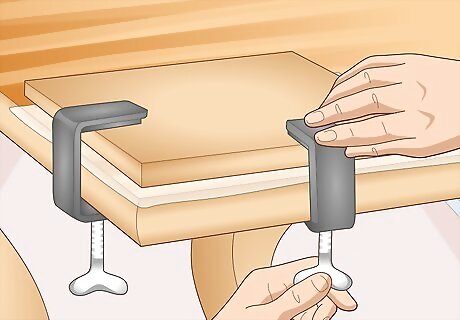
Clamp a flat piece of wood over the patch until the glue dries. Choose a piece of wood that’s larger enough to cover the entire patch and place it on top of the wax paper. Secure C-clamps every 1 foot (30 cm) around the piece of wood to hold the patch tightly against the furniture. Leave the wood clamped overnight so the glue has time to set. Make sure to distribute pressure evenly on the piece of wood or one side of the patch may set higher than the other.
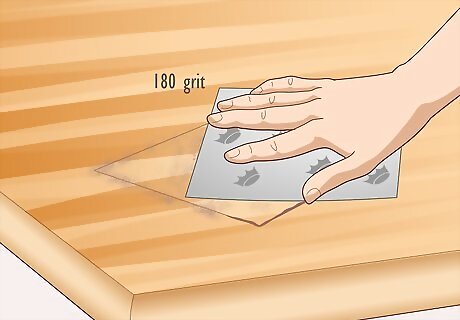
Sand the surface with 180-grit sandpaper to remove residual glue. Take off the clamps and remove the piece of wood and wax paper from the patch. Rub 180-grit sandpaper along the wood grain, focusing on any raised seams or dried glue on the surface. Apply light pressure so you don’t wear through the veneer. Keep sanding until the patch is flush with the original veneer.


















Comments
0 comment